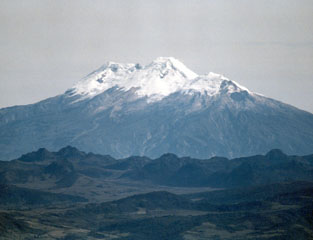Report on Nevado del Huila (Colombia) — 28 July-3 August 2010
Smithsonian Institution / US Geological Survey
Weekly Volcanic Activity Report, 28 July-3 August 2010
Managing Editor: Sally Sennert.
Please cite this report as:
Global Volcanism Program, 2010. Report on Nevado del Huila (Colombia) (Sennert, S, ed.). Weekly Volcanic Activity Report, 28 July-3 August 2010. Smithsonian Institution and US Geological Survey.
Nevado del Huila
Colombia
2.93°N, 76.03°W; summit elev. 5364 m
All times are local (unless otherwise noted)
INGEOMINAS reported that periodically during 26 July-3 August sulfur dioxide plumes from Nevado del Huila were observed by ground-based instruments as well as satellite imagery. During 28-30 July INGEOMINAS noted that ash emissions reported by the Washington VAAC corresponded with increased seismicity. On 28, 30, and 31 July and 1 August gray fumarolic plumes drifting W were seen through the web camera at Tafxnú as well as a new web camera installed at Maravillas (12 km SE of Pico Central). The Alert Level remained at III (Yellow; "changes in the behavior of volcanic activity").
Geological Summary. Nevado del Huila, the highest peak in the Colombian Andes, is an elongated N-S-trending volcanic chain mantled by a glacier icecap. The andesitic-dacitic volcano was constructed within a 10-km-wide caldera. Volcanism at Nevado del Huila has produced six volcanic cones whose ages in general migrated from south to north. The high point of the complex is Pico Central. Two glacier-free lava domes lie at the southern end of the volcanic complex. The first historical activity was an explosive eruption in the mid-16th century. Long-term, persistent steam columns had risen from Pico Central prior to the next eruption in 2007, when explosive activity was accompanied by damaging mudflows.

